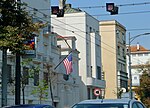Embassy of Ukraine, Belgrade
1995 establishments in SerbiaBuildings and structures in BelgradeDiplomatic missions in SerbiaDiplomatic missions of UkraineSerbia–Ukraine relations

The Embassy of Ukraine in the Republic of Serbia is a diplomatic mission of Ukraine in Serbia, located in the capital city Belgrade.
Excerpt from the Wikipedia article Embassy of Ukraine, Belgrade (License: CC BY-SA 3.0, Authors, Images).Embassy of Ukraine, Belgrade
Paje Adamova, Belgrade Београд (Савски венац)
Geographical coordinates (GPS) Address Phone number External links Nearby Places Show on map
Geographical coordinates (GPS)
| Latitude | Longitude |
|---|---|
| N 44.77272 ° | E 20.46163 ° |
Address
Амбасада Украјине
Paje Adamova 4
11000 Belgrade, Београд (Савски венац)
Central Serbia, Serbia
Open on Google Maps






